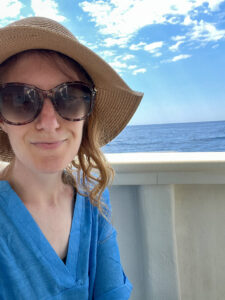
One of my favorite things about summer is stalking everyone’s vacation photos on social media. Even if I’ve never met you in person, you can be sure that I’m watching the Instagram stories of your Amalfi Coast boat ride or your Maine camping trip and living vicariously. This summer it feels like everyone I know is going to Europe, and I’m having a very fun time “exploring” Europe with you from my couch.
The post-pandemic travel wave seems to still be at its peak, and with the Olympics (and Taylor Swift) in Europe this summer, it seems like it’s even more crowded than usual. With the crowds come astronomical prices, unpleasant temperatures, long waits, and sold-out attractions. Rooms are often more than double what they cost in the off-season, and it can feel like you get a lower quality trip for a higher price.

Summer is the season I least recommend visiting (most of) Europe. BUT, for many people, summer is the best or only option. Because of school and work schedules, it’s the only time of year many of us can squeeze in a vacation. Plus, some people just prefer summer travel—especially if they’re going to the amazing weather and long days of Northern Europe or going to float on a boat in the Mediterranean.
There is no wrong time to visit Europe. And even visiting a place at its least-ideal time can be an amazing experience. But in case you’re still working out the details for an upcoming Europe trip this summer or already thinking ahead to next year, here are ten of my top Europe destinations for summer travel. These are places that are far less crowded and far less expensive than Europe’s most visited destinations.
This post may contain affiliate links which earn me a small commission from bookings at no extra cost to you. Thank you for reading and supporting my blog!
In no particular order…


1. Edinburgh and the Scottish Highlands
Scotland gets my vote because of its absolutely perfect weather. (And by perfect weather, I mean perfect to me—a person who typically spends summers half-suffocating and half-melting in the humid furnace of New Orleans.) In Edinburgh, the average highs from June to August are in the mid-60s (Fahrenheit), and the days are long with sunsets close to 10:00pm.
Edinburgh gets plenty of tourists, but nowhere near the crowd sizes of larger cities like London and Paris. But if you want real isolation, you can head into the nature of the Highlands. There are tons of organized tours to places like Loch Ness, Glencoe, and the Isle of Skye.
Accommodations in Edinburgh aren’t cheap, but they are a bit less expensive than the nearest large cities like London and Dublin. Castle Rock Hostel is my favorite in Edinburgh, and you can get very good deals on their rooms if you book in advance. Inverness Student Hotel was also lovely for its proximity to the Highlands. (You don’t have to be a student to stay there.) You can find good hotel rooms and Airbnbs in Edinburgh’s Old Town in the summer for between $150 and $200 USD per night, but the nicer hotels are likely to be in the $200-$300 range.
Be aware though that the Edinburgh Fringe Festival takes place for most of August. This is a wildly popular arts and culture festival that draws crowds from around the world. If you love a vibrant festival environment, visiting Edinburgh in August might be ideal. Otherwise, avoid August and stick with June or July.

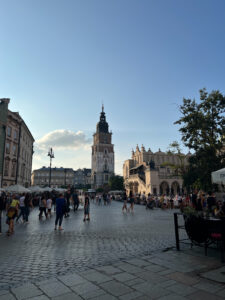
2. Krakow, Poland
I used to assume that Krakow was mostly a destination for people interested in World War II history. And it is certainly that—while in Krakow, you absolutely should NOT miss a visit to Schindler’s Factory and a day trip to see Auschwitz-Birkenau. But Krakow is not sitting in a perpetual state of somber reminiscing about World War II like my high school history classes might have led me to assume. The city is known for its nightlife and summer festivals and youthful population. And it’s very compact, so you can easily walk everywhere. There’s a medieval castle, legends of dragons, delicious food, and so many other reasons why I love it.
Krakow is an incredible place, and I’m not sure why it hasn’t yet reached the level of popularity of the top-visited cities in Western Europe. That’s a good thing though because it means that prices in Krakow are remarkably affordable. Even the nicest accommodations in the center of the Old Town typically cost less than $80 USD per night, and if you’re willing to walk 5-10 minutes to get to the center, you can easily pay $30-50 per night for an Airbnb or hotel room. (Dizzy Daisy Hostel was conveniently located and a very good deal for a private room.) Summer is peak tourist time, so you’ll want to book the most popular tour tickets in advance and make nice restaurant reservations, but you won’t feel crowded.
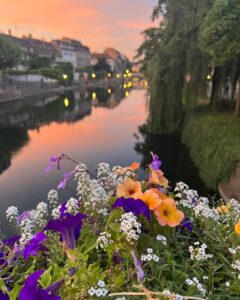

3. Strasbourg, France
It might be unfair for me to put Strasbourg on a summer list because Strasbourg will also go on my winter list. And probably my spring list. In fact, I can’t think of a bad time to visit Strasbourg. It’s less than 2 hours from Paris by the fastest high-speed train, but it feels a world away. Strasbourg is the largest city in the Alsace region of France—a region that borders Germany and has been owned by France and Germany in turns multiple times in the past century. Because of this, it has a unique culture that blends French and German cuisines, traditions, and architecture. It’s the official seat of the European Parliament.
Strasbourg is large enough that there is plenty to do but small enough that it feels quaint and charming. It’s surrounded by dozens of the most picturesque small towns in all of France, and you can easily use Strasbourg as a base for exploring the entire Alsace wine region. But Strasbourg is so charming that the cute towns won’t even feel like a huge temptation. (You should still go visit some!)
In the summer, all the restaurants have outdoor seating, and visitors stay out late eating and socializing. One of the most impressive cathedrals in Europe sits in the center of the Old Town, and if you climb to the top, you can see Germany and the Swiss Alps. It’s far cheaper than Paris, and it’s one of the prettiest cities I’ve ever visited.
The People Hostel has beautiful and surprisingly affordable private rooms, and you can find Airbnbs in the Old Town for around $100 USD per night and hotels for slightly more than that.

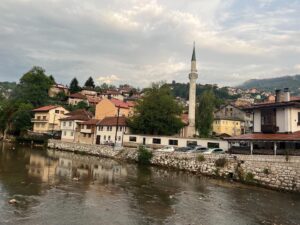
4. Sarajevo, Bosnia and Herzegovina
I’d recommend Sarajevo for any time of year, but it’s a great summer option because it doesn’t see a ton of tourists. While the smaller Bosnian town of Mostar gets a lot of summer tourists because of day-trippers from cruise ships that dock in Croatia and Montenegro, Sarajevo is a couple hours too far inland for the day-trippers to reach. It’s a city that you won’t end up visiting by accident—you have to go out of your way to see it, and a lot of people don’t realize that they should.
Sarajevo is one of the most unique and fascinating cities I’ve ever visited. It has emerged from the war that ravaged it in the early 90s and is now a diverse and vibrant city with a rich and captivating history. The Call to Prayer is interspersed with church bells throughout the day, and the Ottoman influence is everywhere. You could convince yourself you’re in the Middle East here instead of Europe.
Bosnia is one of my very favorite countries, and it’s also one of the most affordable places in Europe. Hostel Kucha has really lovely private rooms, and you can find hotel rooms in or near the Old Town in the summer for between $50 and $70 USD. If you’re willing to walk 10 minutes to get to Old Town, you can find nice Airbnbs for $30-$40 per night. If you’ve visited all the popular cities in Western Europe but haven’t ventured farther east, I highly recommend you experience Sarajevo.
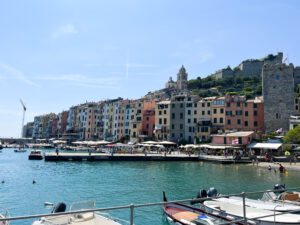
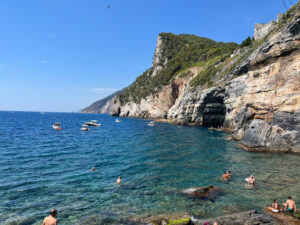
5. Porto Venere, Italy
Porto Venere is almost like a 6th village of Italy’s famous Cinque Terre. But because it’s not technically one of the Cinque Terre villages (and it’s not connected by train the way the rest of the villages are), it gets far fewer visitors. This makes it an excellent place to go in the summer. I’m not suggesting that you shouldn’t visit Cinque Terre as well because you definitely should—just be prepared for the crowds. Porto Venere might be the perfect choice for a quieter place to stay while still giving you easy access to the rest of the Italian Riviera.
Porto Venere is a UNESCO World Heritage Site that sits on the tip of a small peninsula. The buildings boast the vibrant colors that make the Ligurian Coast so recognizable. During the summer, it’s a short ferry ride to all the Cinque Terre villages. Hotels in Porto Venere in the summer are typically between $200 and $250 USD per night, but you can get a good deal if you book in advance. However, if you’re on a budget, I recommend staying in La Spezia—just an hour away by bus. It’s full of affordable accommodations and provides easy bus and train access to the whole Italian Riviera. In La Spezia, hotels are between $115 and $160 USD per night. One of my favorite hostels in Europe, Costello, is in La Spezia, and I highly recommend it for budget solo travelers.
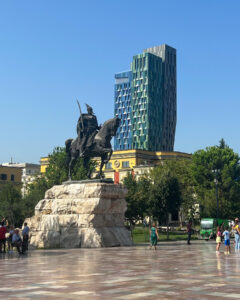
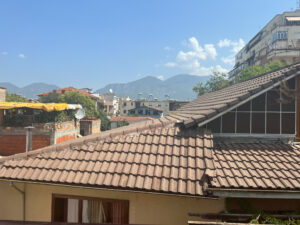
6. Albania
The Albanian Coast is gradually becoming more popular, but it still gets a fraction of the tourists that other Adriatic countries like Croatia, Montenegro, Greece, and Italy get. But there are so many reasons to visit Albania. The nature is stunning, the history is fascinating, and it’s one of the cheapest countries in Europe.
The only place I’ve visited in Albania is Tirana (the capital), and I’m very eager to return and visit places I missed the first time like Gjirokastra, Berat, Theth, and Shkodra. There aren’t many countries in Europe that remain as undiscovered as this one, and it’s well-worth going out of your way to see if you’re looking to get off the beaten path.
Accommodations in Albania are some of the most affordable in all of Europe. I loved staying in a private room at Art Hostel Tirana. You can get a hotel or Airbnb in Tirana during summer for between $30 and $50 USD per night and on the Albanian Riviera for between $50 and $100 USD per night.
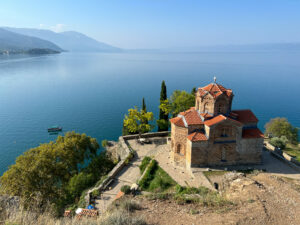
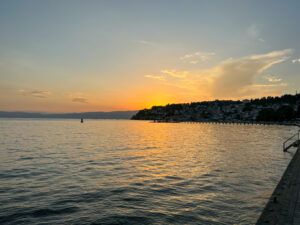
7. Ohrid, North Macedonia
Ohrid is a popular summer vacation destination for people living in Eastern Europe, but somehow they’ve managed to keep it largely secret from the rest of us. Straddling the border of Albania and North Macedonia, Lake Ohrid is believed to be one of the oldest lakes in the world. The town of Ohrid sits on the North Macedonia side and is known for its history, its surrounding nature, and for having 365 monasteries—one for each day of the year. At night, street vendors sell Turkish ice cream, and there are dance and musical performances.
A lot of people visit Ohrid on a day trip from the capital, Skopje, or when passing through to another location, but I spent 3 days in Ohrid and would have happily spent more. It’s peaceful while still having plenty to do, the people are so kind, and the scenery is stunning. Plus, it’s incredibly affordable. You can get a hotel or Airbnb for between $45 and $70 USD, and I stayed in a lovely Airbnb there a couple years ago for about $35 per night.
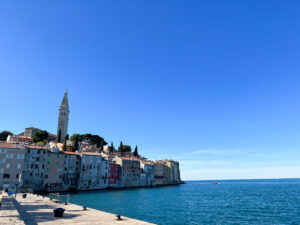
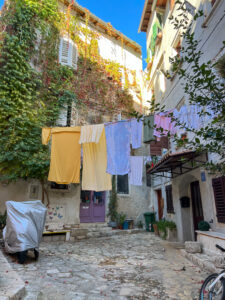
8. Istria, Croatia
Because of the film industry, Croatia has become a wildly popular tourist destination, especially in the summer. But most tourists flock to the cities and islands on Croatia’s Dalmatian Coast like Dubrovnik and Split. A lot of people skip over Croatia’s northwestern region—the Istrian Peninsula. This region borders Slovenia and Italy, and it feels very Italian because of its history, cuisine, and architecture. The largest town on the peninsula, Pula, has an incredibly well-preserved Roman amphitheater, and just 45-minutes away, the town of Rovinj looks like a setting from a storybook with its winding, cobbled streets. This region is known for its wine and olive oil, and it feels like visiting an Italian village but without the same crowds. The towns do see plenty of visitors in the summer, and because accommodations are limited, you’ll want to book them a few months in advance, but it doesn’t get mobbed with the crowds of Croatia’s larger coastal cities or neighboring Venice. You can find hotels and Airbnbs in both Pula and Rovinj for between $100 and $150 in the summer.
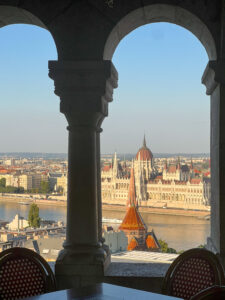
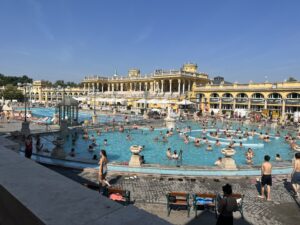
9. Budapest, Hungary
I don’t think there’s a bad time of year to visit Budapest, but if you’re looking for a major European city with thriving culture, I think Budapest is a great summer alternative to the major cities in the west. It’s a huge city (the ninth largest in the European Union), and it can get crowded during the summer. The reason I think it’s a nice alternative to the major Western cities is because it’s so affordable. It has major museums, grand cathedrals, stunning architecture, and a vibrant restaurant and bar scene—all the things visitors like in major European cities but at half the price (or less) than you can visit Paris or London. You could spend all summer floating in the city’s different thermal baths. Admittedly some people might prefer this to be a cold weather activity, but I will not say no to a warm bath any time of the year.
The private room at Lavender Circus Hostel is one of the neatest places I’ve ever stayed anywhere, and though it’s not the cheapest Budapest option, it’s worth the splurge. You can find good hotels or Airbnbs for between $60 and $100 USD per night.
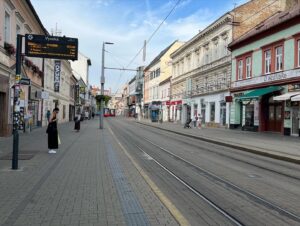

10. Bratislava, Slovakia
Most tourists skip Bratislava without realizing that it’s just an hour by train from Vienna (conveniently in between Vienna and Budapest). A lot of Danube River cruises make a stop in Bratislava, so it sees a lot of day-trippers, but it’s worth staying in Bratislava after the day-trippers leave to fully experience the city. It has a very walkable and adorable old town, a beautiful hill-top castle, delicious food, and it’s very affordable.
CHORS Hostel is on the pricier side (as far as Bratislava prices), but I had a wonderful experience there. Most hotel rooms during summer are between $80 and $90 USD per night, and you can find good Airbnbs for between $50 and $70 USD.
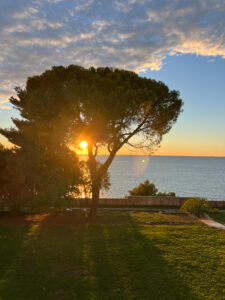
Some places I haven’t visited yet but would love to visit in the summer:
- The Baltic Countries (Estonia, Latvia, and Lithuania)
- All of Scandinavia, but especially Finland. I would love to visit Lapland in the summer and see the midnight sun.
- Gdansk, Poland
- Utrecht, Netherlands
- Tbilisi, Georgia
Don’t forget to reach out to me for help planning your next vacation! I’ve recently become a Travel Advisor, and I’m always looking for opportunities to help travelers. I can help you with a personalized itinerary and access special deals and perks for your accommodations. You can contact me for travel planning here!
